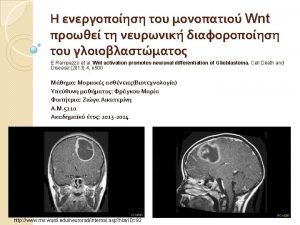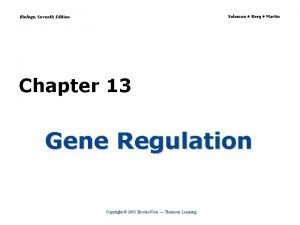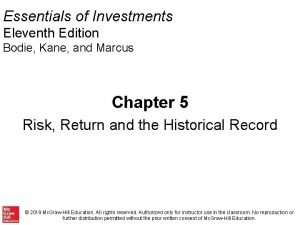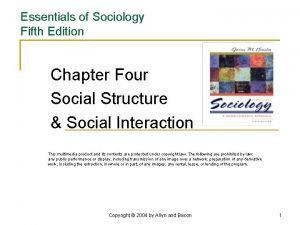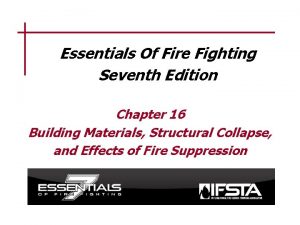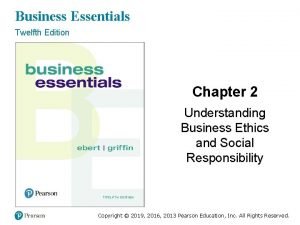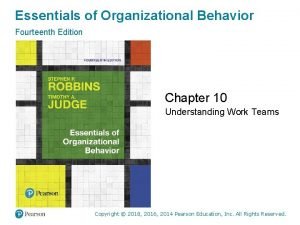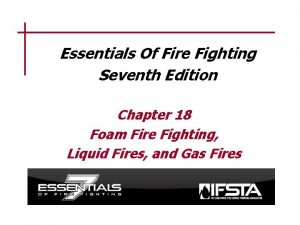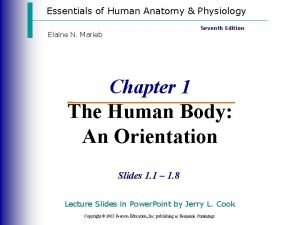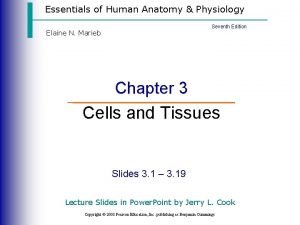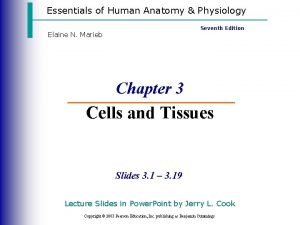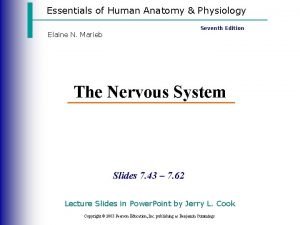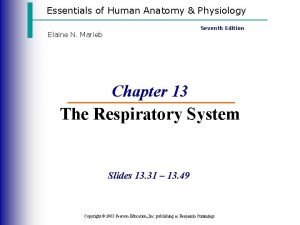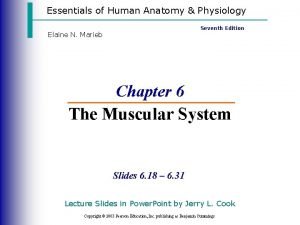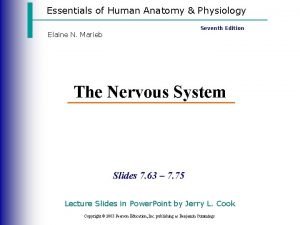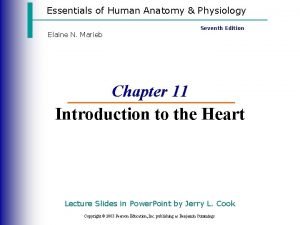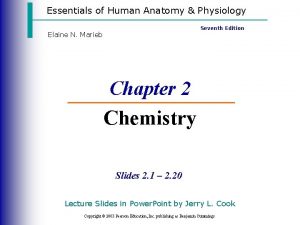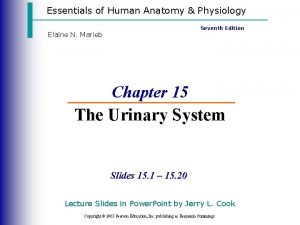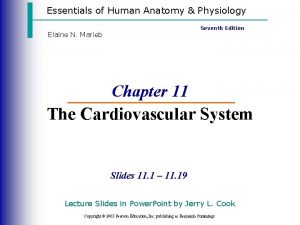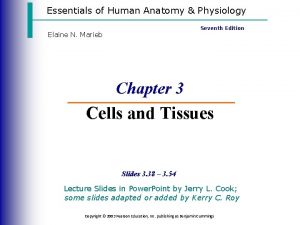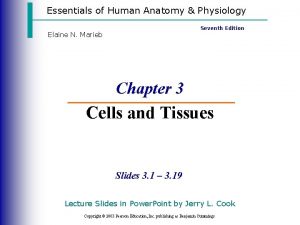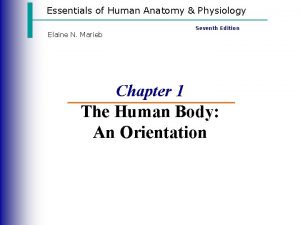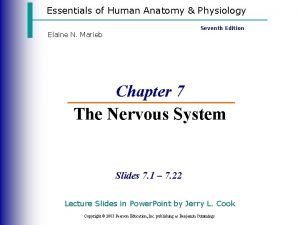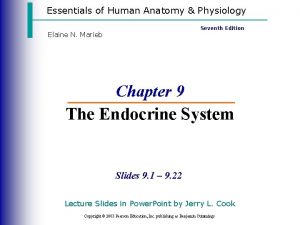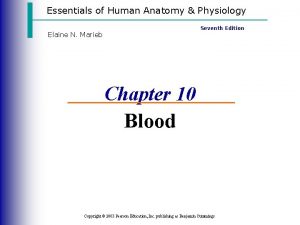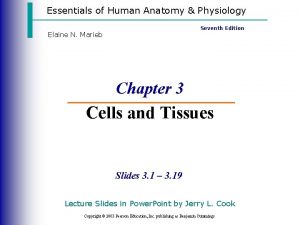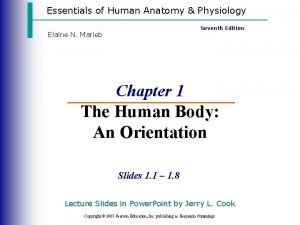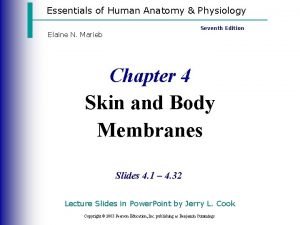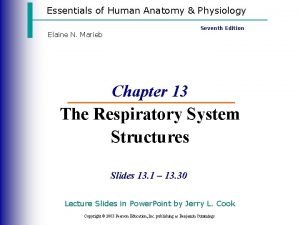Essentials of Human Anatomy Physiology Seventh Edition Elaine













































- Slides: 45

Essentials of Human Anatomy & Physiology Seventh Edition Elaine N. Marieb Chapter 7 The Central Nervous System Slides 7. 26 – 7. 62 Lecture Slides in Power. Point by Jerry L. Cook Copyright © 2003 Pearson Education, Inc. publishing as Benjamin Cummings

Central Nervous System (CNS) · Characteristics: · Size: two fistfuls of pinkish grey tissue · Weighs approx. 3 lbs. · Filled with cerebrospinal fluid · Four major regions – cerebral hemispheres, diencephalon, brain stem and cerebellum Copyright © 2003 Pearson Education, Inc. publishing as Benjamin Cummings Slide 7. 26

Four Major Regions of the Brain · Cerebral hemispheres · Diencephalon · Brain stem · Cerebellum Copyright © 2003 Pearson Education, Inc. publishing as Benjamin Cummings Figure 7. 12 Slide 7. 27

Cerebral Hemispheres (Cerebrum) · Paired (left and right) superior parts of the brain · Include more than half of the brain mass Figure 7. 13 a Copyright © 2003 Pearson Education, Inc. publishing as Benjamin Cummings Slide 7. 28 a

Cerebral Hemispheres (Cerebrum) · The entire surface is made of ridges (gyri) and seperated by grooves (sulci) Copyright © 2003 Pearson Education, Inc. publishing as Benjamin Cummings Figure 7. 13 a Slide 7. 28 b

Lobes of the Cerebrum · Fissures (deep grooves) divide the cerebrum into lobes · Surface lobes of the cerebrum · Frontal lobe · Parietal lobe · Occipital lobe · Temporal lobe Copyright © 2003 Pearson Education, Inc. publishing as Benjamin Cummings Slide 7. 29 a

Lobes of the Cerebrum Figure 7. 15 a Copyright © 2003 Pearson Education, Inc. publishing as Benjamin Cummings Slide 7. 29 b

Specialized Areas of the Cerebrum (Speech, memory, logical and emotional response, consciousness, intrepretation of sensation, voluntary movement) · Somatic sensory area (parietal lobe)– receives impulses from the body’s sensory receptors · Allows you to recognize pain, coldness, light touch Copyright © 2003 Pearson Education, Inc. publishing as Benjamin Cummings Slide 7. 30

• Primary motor area – sends impulses to skeletal muscles • Allows us to consciously move our skeletal muscles

• Broca’s area – involved in our ability to speak

Sensory and Motor Areas of the Cerebral Cortex Figure 7. 14 Copyright © 2003 Pearson Education, Inc. publishing as Benjamin Cummings Slide 7. 31

Layers of the Cerebrum · Gray matter · Outer layer · Composed mostly of neuron cell bodies Figure 7. 13 a Copyright © 2003 Pearson Education, Inc. publishing as Benjamin Cummings Slide 7. 33 a

Layers of the Cerebrum · White matter · Fiber tracts inside the gray matter · Example: corpus callosum connects hemispheres Figure 7. 13 a Copyright © 2003 Pearson Education, Inc. publishing as Benjamin Cummings Slide 7. 33 b

Diencephalon · Sits on top of the brain stem · Enclosed by the cerebral heispheres · Made of three parts: · Thalamus · Hypothalamus · Epithalamus Slide 7. 34 a

Thalamus · Surrounds the third ventricle · The relay station for sensory impulses · Transfers impulses to the correct part of the cortex for localization and interpretation · Interprets if sensation is pleasant or unpleasant Copyright © 2003 Pearson Education, Inc. publishing as Benjamin Cummings Slide 7. 35

Hypothalamus · Under the thalamus · Important autonomic nervous system center · Helps regulate body temperature · Controls water balance · Regulates metabolism · An important part of the limbic system (emotions) · The pituitary gland is attached to the hypothalamus Copyright © 2003 Pearson Education, Inc. publishing as Benjamin Cummings Slide 7. 36 a

Epithalamus · Forms the roof of the third ventricle · Houses the pineal body (an endocrine gland) · Includes the choroid plexus – forms cerebrospinal fluid Copyright © 2003 Pearson Education, Inc. publishing as Benjamin Cummings Slide 7. 37

Brain Stem · Attaches to the spinal cord · Parts of the brain stem · Midbrain · Pons · Medulla oblongata Copyright © 2003 Pearson Education, Inc. publishing as Benjamin Cummings Slide 7. 38 a

Midbrain · Mostly composed of tracts of nerve fibers · Has two bulging fiber tracts – cerebral peduncles · Has four rounded protrusions – corpora quadrigemina · Reflex centers for vision and hearing Copyright © 2003 Pearson Education, Inc. publishing as Benjamin Cummings Slide 7. 39

Pons · The bulging center part of the brain stem · Mostly composed of fiber tracts · Includes nuclei involved in the control of breathing Copyright © 2003 Pearson Education, Inc. publishing as Benjamin Cummings Slide 7. 40

Medulla Oblongata · The lowest part of the brain stem · Merges into the spinal cord · Includes important fiber tracts · Contains important control centers · Heart rate control · Blood pressure regulation · Breathing · Swallowing · Vomiting Copyright © 2003 Pearson Education, Inc. publishing as Benjamin Cummings Slide 7. 41

Cerebellum · Two hemispheres with convoluted surfaces · Provides involuntary coordination of body movements Copyright © 2003 Pearson Education, Inc. publishing as Benjamin Cummings Slide 7. 43 a

Protection of the Central Nervous System · Scalp and skin · Skull and vertebral column · Meninges · Cerebrospinal fluid · Blood brain barrier Copyright © 2003 Pearson Education, Inc. publishing as Benjamin Cummings Figure 7. 16 a Slide 7. 44 a

Meninges Consists of: Dura mater, Arachnoid mater, and pia mater 1. Dura mater · Double-layered external covering · Periosteum – attached to surface of the skull · Meningeal layer – outer covering of the brain · Folds inward in several areas Slide 7. 45 a

Meninges 2. Arachnoid layer · Middle layer · Web-like 3. Pia mater · Internal layer · Clings to the surface of the brain Copyright © 2003 Pearson Education, Inc. publishing as Benjamin Cummings Slide 7. 45 b

Cerebrospinal Fluid · Similar to blood plasma composition · Formed by the choroid plexus · Forms a watery cushion to protect the brain · Circulated in arachnoid space, ventricles, and central canal of the spinal cord Copyright © 2003 Pearson Education, Inc. publishing as Benjamin Cummings Slide 7. 46

Ventricles and Location of the Cerebrospinal Fluid Figure 7. 17 a Copyright © 2003 Pearson Education, Inc. publishing as Benjamin Cummings Slide 7. 47 a

Ventricles and Location of the Cerebrospinal Fluid Figure 7. 17 b Copyright © 2003 Pearson Education, Inc. publishing as Benjamin Cummings Slide 7. 47 b

Blood Brain Barrier · Includes the least permeable capillaries of the body · Excludes many potentially harmful substances · Useless against some substances · Fats and fat soluble molecules · Respiratory gases · Alcohol · Nicotine · Anesthesia Copyright © 2003 Pearson Education, Inc. publishing as Benjamin Cummings Slide 7. 48

Traumatic Brain Injuries · Concussion · Slight brain injury · No permanent brain damage · Contusion · Nervous tissue destruction occurs · Nervous tissue does not regenerate · Cerebral edema · Swelling from the inflammatory response · May compress and kill brain tissue Copyright © 2003 Pearson Education, Inc. publishing as Benjamin Cummings Slide 7. 49

Cerebrovascular Accident (CVA) · Commonly called a stroke · The result of a ruptured blood vessel supplying a region of the brain · Brain tissue supplied with oxygen from that blood source dies · Loss of some functions or death may result Copyright © 2003 Pearson Education, Inc. publishing as Benjamin Cummings Slide 7. 50

Alzheimer’s Disease · Progressive degenerative brain disease · Mostly seen in the elderly, but may begin in middle age · Structural changes in the brain include abnormal protein deposits and twisted fibers within neurons · Victims experience memory loss, irritability, confusion and ultimately, hallucinations and death Copyright © 2003 Pearson Education, Inc. publishing as Benjamin Cummings Slide 7. 51

Spinal Cord · Extends from the medulla oblongata to the region of T 12 · Below T 12 is the cauda equina (a collection of spinal nerves) · Enlargements occur in the cervical and lumbar regions Figure 7. 18 Copyright © 2003 Pearson Education, Inc. publishing as Benjamin Cummings Slide 7. 52

Spinal Cord Anatomy · Exterior white mater – conduction tracts Figure 7. 19 Copyright © 2003 Pearson Education, Inc. publishing as Benjamin Cummings Slide 7. 53 a

Spinal Cord Anatomy · Internal gray matter - mostly cell bodies · Dorsal (posterior) horns · Anterior (ventral) horns Figure 7. 19 Copyright © 2003 Pearson Education, Inc. publishing as Benjamin Cummings Slide 7. 53 b

Spinal Cord Anatomy · Central canal filled with cerebrospinal fluid Figure 7. 19 Copyright © 2003 Pearson Education, Inc. publishing as Benjamin Cummings Slide 7. 53 c

Spinal Cord Anatomy · Meninges cover the spinal cord · Nerves leave at the level of each vertebrae · Dorsal root · Associated with the dorsal root ganglia – collections of cell bodies outside the central nervous system · Ventral root Copyright © 2003 Pearson Education, Inc. publishing as Benjamin Cummings Slide 7. 54

Peripheral Nervous System · Nerves and ganglia outside the central nervous system · Nerve = bundle of neuron fibers · Neuron fibers are bundled by connective tissue Copyright © 2003 Pearson Education, Inc. publishing as Benjamin Cummings Slide 7. 55

Structure of a Nerve · Endoneurium surrounds each fiber · Groups of fibers are bound into fascicles by perineurium · Fascicles are bound together by epineurium Figure 7. 20 Copyright © 2003 Pearson Education, Inc. publishing as Benjamin Cummings Slide 7. 56

Classification of Nerves · Mixed nerves – both sensory and motor fibers · Afferent (sensory) nerves – carry impulses toward the CNS · Efferent (motor) nerves – carry impulses away from the CNS Copyright © 2003 Pearson Education, Inc. publishing as Benjamin Cummings Slide 7. 57

Cranial Nerves · 12 pairs of nerves that mostly serve the head and neck · Numbered in order, front to back · Most are mixed nerves, but three are sensory only Copyright © 2003 Pearson Education, Inc. publishing as Benjamin Cummings Slide 7. 58

Distribution of Cranial Nerves Figure 7. 21 Copyright © 2003 Pearson Education, Inc. publishing as Benjamin Cummings Slide 7. 59

Cranial Nerves · I Olfactory nerve – sensory for smell · II Optic nerve – sensory for vision · III Oculomotor nerve – motor fibers to eye muscles · IV Trochlear – motor fiber to eye muscles Copyright © 2003 Pearson Education, Inc. publishing as Benjamin Cummings Slide 7. 60

Cranial Nerves · V Trigeminal nerve – sensory for the face; motor fibers to chewing muscles · VI Abducens nerve – motor fibers to eye muscles · VII Facial nerve – sensory for taste; motor fibers to the face · VIII Vestibulocochlear nerve – sensory for balance and hearing Copyright © 2003 Pearson Education, Inc. publishing as Benjamin Cummings Slide 7. 61

Cranial Nerves · IX Glossopharyngeal nerve – sensory for taste; motor fibers to the pharynx · X Vagus nerves – sensory and motor fibers for pharynx, larynx, and viscera · XI Accessory nerve – motor fibers to neck and upper back · XII Hypoglossal nerve – motor fibers to tongue Copyright © 2003 Pearson Education, Inc. publishing as Benjamin Cummings Slide 7. 62
 Human anatomy and physiology seventh edition marieb
Human anatomy and physiology seventh edition marieb Uterus perimetrium
Uterus perimetrium Anatomy and physiology ninth edition
Anatomy and physiology ninth edition Chapter 1 introduction to human anatomy and physiology
Chapter 1 introduction to human anatomy and physiology Holes essential of human anatomy and physiology
Holes essential of human anatomy and physiology Anterior posterior distal proximal
Anterior posterior distal proximal Chapter 2 human reproductive anatomy and physiology
Chapter 2 human reproductive anatomy and physiology Chords rule in dbms
Chords rule in dbms Principles of management information system
Principles of management information system Molecular biology of the cell seventh edition
Molecular biology of the cell seventh edition Biology seventh edition
Biology seventh edition Human anatomy fifth edition
Human anatomy fifth edition Human anatomy fifth edition
Human anatomy fifth edition Network security essentials 5th edition
Network security essentials 5th edition Business essentials 12th edition
Business essentials 12th edition Essentials of investments 11th edition
Essentials of investments 11th edition Business essentials 12th edition
Business essentials 12th edition Essentials of sociology 5th edition
Essentials of sociology 5th edition Firefighter essentials 7th edition
Firefighter essentials 7th edition Business essentials 12th edition
Business essentials 12th edition Management information systems 13th edition
Management information systems 13th edition Types of group
Types of group At a bulk transport incident firefighters must
At a bulk transport incident firefighters must Cryptographic systems are generically classified by
Cryptographic systems are generically classified by Criminal justice wedding cake diagram
Criminal justice wedding cake diagram Physiology of sport and exercise 5th edition
Physiology of sport and exercise 5th edition Lower respiratory tract
Lower respiratory tract Tattoo anatomy and physiology
Tattoo anatomy and physiology Science olympiad anatomy and physiology
Science olympiad anatomy and physiology External parts of a leaf
External parts of a leaf Anatomy and physiology bone
Anatomy and physiology bone Peptic ulcer anatomy and physiology
Peptic ulcer anatomy and physiology Cantlie line
Cantlie line Difference between anatomy and physiology
Difference between anatomy and physiology Difference between anatomy and physiology
Difference between anatomy and physiology Google com
Google com Chapter 14 anatomy and physiology
Chapter 14 anatomy and physiology Http://anatomy and physiology
Http://anatomy and physiology Appendix physiology
Appendix physiology Aohs foundations of anatomy and physiology 1
Aohs foundations of anatomy and physiology 1 Aohs foundations of anatomy and physiology 1
Aohs foundations of anatomy and physiology 1 Anatomy and physiology of swine
Anatomy and physiology of swine Anatomy and physiology chapter 8 special senses
Anatomy and physiology chapter 8 special senses Chapter 13 anatomy and physiology of pregnancy
Chapter 13 anatomy and physiology of pregnancy Unit 26 self evaluation answers
Unit 26 self evaluation answers Science olympiad forensics cheat sheet
Science olympiad forensics cheat sheet









